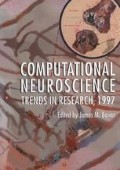Abstract
Recent experimental evidence suggests that the hippocampus replays a temporally compressed version of recently-learned spatial sequence information during slow-wave sleep. This phase of sleep is characterized by intermittent episodes of high-frequency firing known as sharp waves. Here we partially characterize a simplified neural network model of hippocampal area CA3, based on integrate-and-fire cells, which is capable of recalling temporally compressed sequence information during brief periods of high activity.
Access this chapter
Tax calculation will be finalised at checkout
Purchases are for personal use only
Preview
Unable to display preview. Download preview PDF.
References
DA August and W B Levy. Temporal sequence compression by a hippocampal network model. In INNS World Congress on Neural Networks,pages 1299–1303, Mahwah, NJ, 1996. Lawrence Erlbaum.
T V P Bliss and T Lorno. Long-lasting potentiation of synaptic transmission in the dentate area of the anaesthetized rabbit following stimulation of the perforant path. J. Physiol., 232: 331–356, 1973.
G Buzsaki. Hippocampal sharp waves: Their origin and significance. Brain Res., 398: 242–252, 1986.
G Buzsaki. Two-stage model of memory trace formation: A role for ‘noisy’ brain states. Neuroscience, 31 (3): 551–570, 1989.
G Buzsaki, Z Horvath, R Urioste, J Hetke, and K Wise. High-frequency network oscillation in the hippocampus. Science, 256: 1025–1027, 1992.
ME Hasselmo, E Schnell, and E Barkai. Dynamics of learning and recall at excitatory recurrent synapses and cholinergic modulation in rat hippocampal region CA3. J Neurosci., 15(71): 5249–5262, 1995.
N Ishizuka, J Weber, and DG Amaral. Organization of intrahippocampal projections originating from CA3 pyramidal cells in the rat. J. Comp. Neurol., 295: 580–623, 1990.
WB Levy and O Steward. Synapses as associative memory elements in the hippocampal formation. Brain Res., 175: 233–245, 1979.
WB Levy and O Steward. Temporal contiguity requirements for long-term associative potentiation/depression in the hippocampus. Neuroscience, 8 (41): 791–797, 1983.
H Markram and MV Tsodyks. Redistribution of synaptic efficacy between neocortical pyramidal cells. Nature, 382: 807–810, 1996.
D Marr. Simple memory: a theory for archicortex. Phil. Trans. Royal. Soc. Lond., 262: 23–81, 1971.
R Miles and RKS Wong. Single neurones can initiate synchronized population discharge in the hippocampus. Nature, 306: 371–373, 1983.
AA Minai and WB Levy. The dynamics of sparse random networks. Biol. Cybern., 70: 177–187, 1993.
M Nakao, K Watanabe, T Takahashi, Y Mizutani, and M Yamamoto. Structural properties of network attractor associated with neuronal dynamics transition. In Proceedings of the International Joint Conference of Neural Networks, volume 3, pages 529–534. Inst. of Electrical and Electronic Engineers, 1992.
J O’Keefe and L Nadel. The Hippoccnnpus as a Cognitive Map. Oxford: Clarendon Press, London, 1978.
C Pavlides and J Winson. Influences of hippocampal place cell firing in the awake state on the activity of these cells during subsequent sleep episodes..1 Neurosci., 9 (8): 2907–2918, 1989.
ET Rolls. Functions of neuronal networks in the hippocampus and cerebral cortex in memory. In R M J Cotterill, editor, Models of Brain Function, pages 15–33. Cambridge Univ. Press, 1989.
WE Skaggs and B L McNaughton. Replay of neuronal firing sequences in rat hippocampus during sleep following spatial experience. Science, 271: 1870–1873, 1996.
SS Suzuki and GK Smith, Spontaneous EEG spikes in the normal hippocampus. 1. Behavioral correlates. laminar profiles and bilateral synchrony. Electroenceph. Clin. Neurophys., 67 (41): 348–359, 1987.
M Usher, M Stemmler, C Koch, and Z Olami. Network amplification of local fluctuations causes high spike rate variability, fractal firing patterns and oscillatory local field potentials. Neural Computation, 6 (5): 795–836, 1994.
MA Wilson and BL McNaughton. Reactivation of hippocampal ensemble memories during sleep. Science. 265: 676–679, 1994.
S Zola-Morgan and LR Squire. The primate hippocampal formation: Evidence for a time-limited role in memory storage. Science, 250: 288–290, 1990.
Author information
Authors and Affiliations
Editor information
Editors and Affiliations
Rights and permissions
Copyright information
© 1997 Springer Science+Business Media New York
About this chapter
Cite this chapter
August, D.A., Levy, W.B. (1997). Spontaneous Replay of Temporally Compressed Sequences by a Hippocampal Network Model. In: Bower, J.M. (eds) Computational Neuroscience. Springer, Boston, MA. https://doi.org/10.1007/978-1-4757-9800-5_38
Download citation
DOI: https://doi.org/10.1007/978-1-4757-9800-5_38
Publisher Name: Springer, Boston, MA
Print ISBN: 978-1-4757-9802-9
Online ISBN: 978-1-4757-9800-5
eBook Packages: Springer Book Archive

